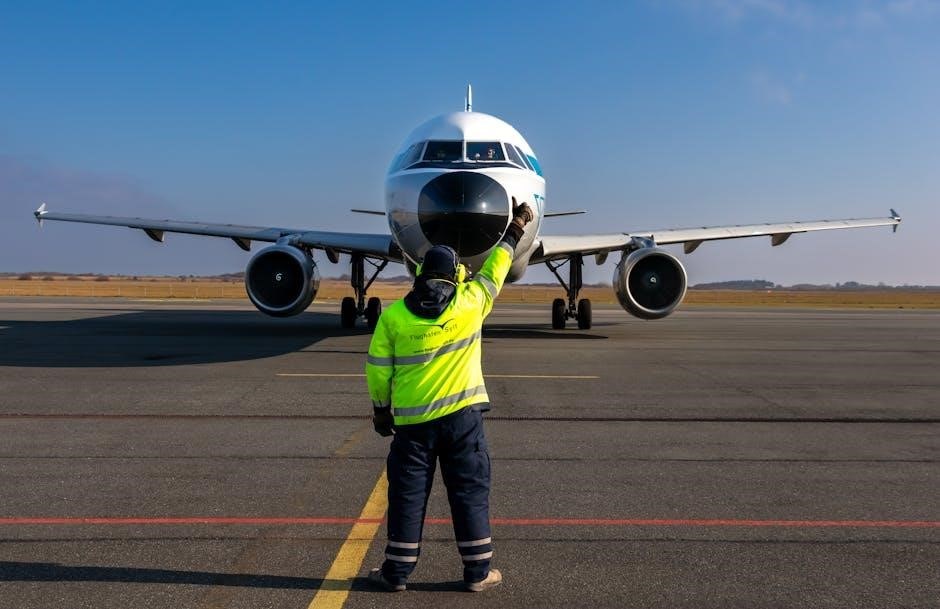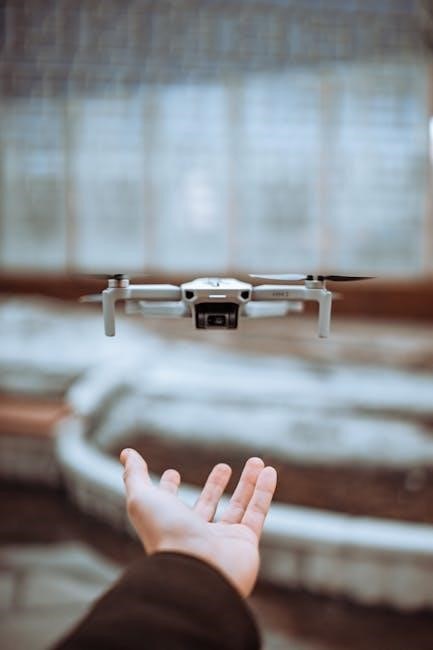Aircraft marshalling hand signals are a critical system of visual communication used to guide aircraft safely and efficiently on the ground. These standardized gestures, outlined in ICAO and IATA guidelines, ensure clear direction for pilots during taxiing, parking, and other ground operations, overcoming challenges like high noise levels and limited visibility.
Importance of Marshalling in Aircraft Operations
Aircraft marshalling is a critical component of ground operations, ensuring the safe and efficient movement of aircraft on the ground. Standardized hand signals, as outlined in ICAO Annex 2 and IATA guidelines, play a vital role in overcoming challenges like high noise levels and limited visibility. Marshalling prevents accidents by providing clear, unambiguous instructions to pilots during taxiing, parking, and engine start-up. It also minimizes delays by enabling precise communication between ground personnel and aircrew. Effective marshalling is essential for maintaining operational safety, reducing the risk of collisions, and ensuring compliance with international aviation standards. Proper training and adherence to these signals are paramount to uphold safety and efficiency in all ground handling procedures.
Standardized Marshalling Signals
Standardized marshalling signals are universal, ensuring clear communication between ground personnel and pilots. Illuminated hands enhance visibility, especially at night, following ICAO and IATA guidelines for precise aircraft direction.
Overview of ICAO Annex 2 (Rules of the Air) Signals
ICAO Annex 2 outlines standardized marshalling signals, ensuring global consistency in ground-to-air communication. These signals, detailed in the Annex, include gestures for direction, speed, and specific aircraft actions. Marshals must use illuminated hands for visibility, particularly at night, and position themselves where pilots can clearly see them. For fixed-wing aircraft, marshals stand on the left side, while for helicopters, visibility by the pilot is key. Signals cover commands like “slow down,” “turn left,” and “brakes engaged,” with specific hand movements prescribed for each action. Training and qualification are mandatory to perform these signals accurately, ensuring safety and efficiency in aircraft operations worldwide.

Roles and Responsibilities in Aircraft Marshalling
Aircraft marshals are responsible for guiding aircraft safely using hand signals, ensuring clear communication, maintaining safety, and adhering to ICAO standards to prevent accidents and ensure efficient ground operations.
Qualifications and Training for Aircraft Marshals
Aircraft marshals must undergo specialized training and meet strict qualifications to perform their duties safely and effectively. Training programs cover ICAO Annex 2 standards, hand signal procedures, and ground operational protocols. Marshals are trained to communicate clearly with pilots, understand aircraft movements, and handle emergencies. They must pass practical assessments to demonstrate proficiency in issuing signals and ensuring safe aircraft positioning. Training also includes understanding aircraft types, ground handling procedures, and safety regulations. Regular refresher courses are required to maintain certification. Only authorized personnel, certified by a CAA-approved organization, are permitted to marshal aircraft, ensuring compliance with international aviation standards for safety and efficiency.

Safety Protocols in Marshalling
Safety protocols in marshalling ensure clear communication and precise aircraft guidance, adhering to ICAO standards. Marshals use illuminated hands and strategic positioning for optimal visibility, minimizing risks and ensuring efficient ground operations.
Ensuring Clear Communication Between Marshal and Pilot
Clear communication between the marshal and pilot is essential for safe aircraft operations. Standardized hand signals, as outlined in ICAO Annex 2, ensure consistency and clarity. Marshals must position themselves where the pilot can easily see them, using illuminated hands at night for better visibility. Acknowledgement signals from the pilot confirm understanding, while precise gestures prevent misunderstandings. Regular training ensures both parties are familiar with the signals, reducing errors during ground maneuvers. Effective communication is critical, especially in noisy environments, to guide aircraft safely and efficiently. Proper protocols minimize risks and ensure smooth ground operations.
Common Marshalling Hand Signals
Common marshalling hand signals include slow down, turn left/right, move ahead/back, brakes engaged, and chocks inserted. These gestures are standardized to ensure clear communication and safety during ground operations.
Key Signals for Fixed-Wing Aircraft and Helicopters
Key signals for fixed-wing aircraft and helicopters ensure safe ground operations. For fixed-wing aircraft, marshals position themselves on the left side, visible to the pilot, using signals like slow down (palm down, arm across body) and turn left/right (extended arm with palm direction). Helicopters require marshals to stand where the pilot has clear visibility, often using similar gestures but adapted for rotorcraft. Unique signals for helicopters include rotor start (circular motion overhead) and hover (hand held steady above head). These signals are standardized to prevent confusion and ensure precise communication, with illuminated hands enhancing visibility at night.
Mарshalling at Night

Мarshalling at Night
Marshalling at night requires enhanced visibility to ensure safety. Illuminated gloves or wands are used to perform signals, with bright colors and reflective materials aiding pilot visibility in low-light conditions.
Use of Illuminated Hands for Better Visibility
Marshalling at night requires enhanced visibility to ensure clear communication between the marshal and the pilot. Illuminated hands or gloves are essential for performing signals in low-light conditions. According to ICAO guidelines, marshals use reflective or LED-enhanced gloves to make hand signals more visible. This ensures that pilots can easily interpret directions, such as “slow down” or “turn left,” even in darkness. The illuminated hands must be positioned where the pilot can see them clearly, typically on the aircraft’s left side for fixed-wing planes. Consistent and precise movements are critical to avoid confusion. This method is vital for maintaining safety and efficiency during nighttime ground operations.

Special Signals for Technical Servicing
Special signals are used for specific technical tasks, such as brakes engaged or released, and chocks inserted or removed. These gestures ensure safe aircraft servicing procedures.
Examples of Brakes Engaged and Chocks Inserted Signals
Specific hand signals are used to indicate technical actions during aircraft servicing. For brakes engaged, the marshaller raises their arm, extends their fingers, and then clenches their fist. For brakes released, the process is reversed: the arm is raised with a clenched fist, which then extends. Chocks inserted is signaled by extending both arms, palms outward, and bringing hands together in front. Chocks removed involves crossing arms, palms outward, and then extending them. These standardized gestures ensure clear communication and safety during ground operations, adhering to ICAO and IATA guidelines.
International Standards and Guidelines
International standards for aircraft marshalling are defined by ICAO Annex 2 and IATA guidelines, ensuring global consistency and safety in ground operations.
ICAO and IATA Recommendations for Marshalling
The ICAO Annex 2 and IATA guidelines provide comprehensive recommendations for aircraft marshalling, emphasizing standardized hand signals to ensure clear communication between marshals and pilots. These recommendations include specific gestures for actions such as stop, go, slow down, and directional movements. Additionally, they stress the importance of illuminated hands for night operations and the necessity of proper training for marshals. Compliance with these standards is crucial for maintaining safety and efficiency in ground operations worldwide. By adhering to these guidelines, aviation personnel can minimize risks and ensure seamless communication, even in challenging environments.


